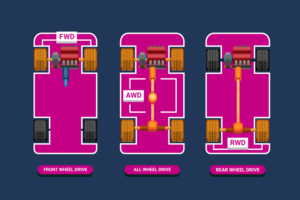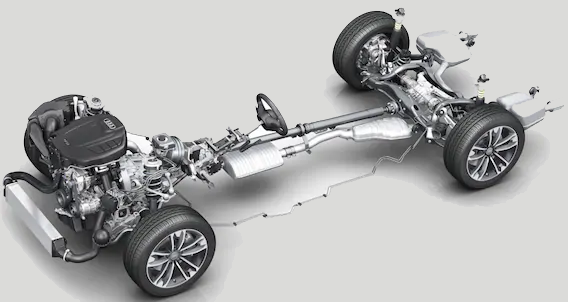What Is The Difference Between AWD, RWD, And FWD? Are you fond of cars? Well, if yes then you must be aware that there are a total of 3 drivetrains or better say powertrains and when it comes to automobile drivetrains, all of the three primary configurations that dictate how power is distributed to the wheels: all-wheel drive (AWD), rear-wheel drive (RWD), and front-wheel drive (FWD). Each configuration offers distinct advantages and disadvantages, making the choice dependent on specific driving needs and preferences So, if you are keen to know about these power or better say drivetrains then be here till the end.
So, it can not be doubted that everyone single person has their own needs for driving. Where some people drive in cities and on plain roads, so they often prefer to own either a front-wheel drive or a rear-wheel drive. While, some people who love more power and drive in mountains and some other off road tracks, they often prefer to own an all wheel drive that we all know as 4WD. Although, if you are someone who is fond of 4-wheel drive then you all must be in the swim that more power means more fuel consumption and more service cost and other expenses.

Front-Wheel Drive (FWD)
So, talking from the very beginning of the first options, then FWD is the most common drivetrain configuration that is found in passenger cars and smaller vehicles. In this setup, the engine’s power is transmitted to the front wheels, which are responsible for both power delivery and steering. This configuration allows for an easier and more compact drivetrain, contributing to fuel efficiency and cost-effectiveness. FWD vehicles typically have better traction in slippery conditions, as the engine’s weight rests on the driven wheels.
Moreover, FWD offers enhanced interior space as there is no need for a driveshaft tunnel running to the rear of the vehicle. But when it comes to talking about the negative point for this segment, then it has been seen that FWD vehicles tend to suffer from understeer, especially when pushed to their limits. This occurs when the front wheels lose grip and fail to respond to steering inputs, resulting in a loss of control. Additionally, FWD vehicles may struggle with excessive torque steer, which is a phenomenon where the power delivered to the wheels causes the vehicle to pull to one side under hard acceleration.
Rear-Wheel Drive (RWD)
When it comes to talking about the Rear Wheel Drive, then RWD which is historically popular in sports cars and larger luxury sedans, is a configuration where power is transmitted to the rear wheels. The front wheels are responsible for steering alone, while the rear wheels handle acceleration. RWD offers a more balanced weight distribution, providing improved handling characteristics and better traction during high-performance driving.
This setup allows for more predictable and enjoyable handling dynamics, particularly in cornering. The separation of steering and acceleration forces in RWD vehicles reduces the likelihood of torque steer, resulting in a more controlled driving experience. Additionally, RWD offers a better power-to-weight ratio and improved towing capabilities. However, RWD vehicles may be less efficient in slippery or snowy conditions due to the reduced weight of the driven wheels.
All-Wheel Drive (AWD)
Heading towards the end of the list, then as the name suggests, AWD systems divide the power to all four wheels of a vehicle. This configuration can be further divided into full-time AWD and part-time AWD. Full-time AWD constantly sends power to all wheels, adjusting the torque distribution based on various factors such as road conditions and driver inputs. Part-time AWD primarily powers two wheels but can engage the other two wheels when additional traction is needed.
AWD offers superior traction and stability, making it ideal for adverse weather conditions and off-road driving. It provides enhanced grip and control, as power can be transferred between wheels to maximize traction in real-time. AWD vehicles typically exhibit excellent acceleration and are well-suited for high-performance applications. However, we would like to tell you that AWD and 4WD are not similar and same because both have different capabilities in the terms of power.
However, AWD systems tend to be heavier, more complex, and less fuel-efficient than their FWD or RWD counterparts. They also come at a higher cost due to the additional components required. Moreover, AWD does not guarantee invincibility in all situations and may not be necessary for drivers who predominantly encounter normal road conditions.
Which Is Best Between AWD & RWD?
Finally, when it comes to talking about choosing between AWD, RWD, and FWD ultimately depends on your driving needs, preferences, and the prevailing road conditions. FWD offers cost-effectiveness, fuel efficiency, and good traction in slippery conditions. RWD provides balanced handling, improved performance, and a more engaging driving experience. AWD excels in challenging terrains, adverse weather conditions, and situations that demand exceptional traction and stability.
However, saying this would not be bad because it is mandatory for you to consider factors such as driving style, climate, terrain, and intended use when making a decision. Manufacturers are continually improving drivetrain technologies, blurring the lines between the advantages and disadvantages of each configuration. Ultimately, the “best” drivetrain is subjective, and it is essential to test-drive different models to determine which one aligns with your preferences and requirements. Follow us for more comparisons.
Image Credit:- Creditplus






GIPHY App Key not set. Please check settings